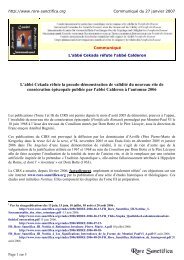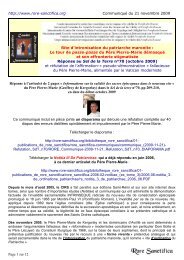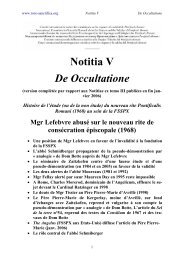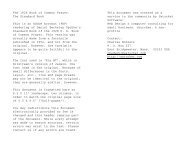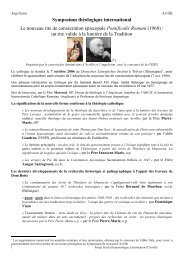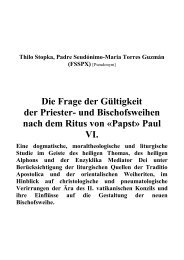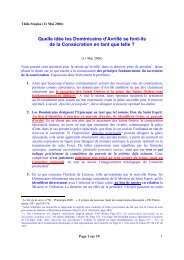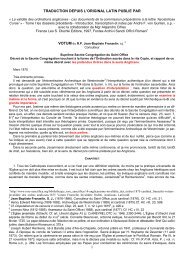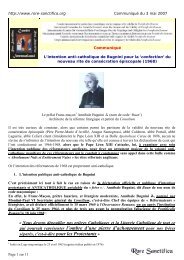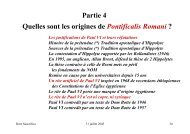THE ORDER OF MELCHISEDECH A Defence of ... - Rore Sanctifica
THE ORDER OF MELCHISEDECH A Defence of ... - Rore Sanctifica
THE ORDER OF MELCHISEDECH A Defence of ... - Rore Sanctifica
Create successful ePaper yourself
Turn your PDF publications into a flip-book with our unique Google optimized e-Paper software.
Pope Leo XIII noted the manner in which the Anglican Reformers brought their new Ordinal into<br />
line with the Protestant heresy:<br />
For the full and accurate understanding <strong>of</strong> the Anglican Ordinal, besides what we have noted as to<br />
some <strong>of</strong> its parts, there is nothing more pertinent than to consider carefully the circumstances under<br />
which it was composed and publicly authorised. It would be tedious to enter into details, nor is it<br />
necessary to do so, as the history <strong>of</strong> that time is sufficiently eloquent as to the animus <strong>of</strong> the authors<br />
<strong>of</strong> the Ordinal against the Catholic Church; as to the abettors whom they associated with themselves<br />
from the heterodox sects; and as to the end they had in view. Being fully cognisant <strong>of</strong> the necessary<br />
connection between faith and worship, between "the law <strong>of</strong> believing and the law <strong>of</strong> praying", under<br />
a pretext <strong>of</strong> returning to the primitive form, they corrupted the Liturgical Order in many ways to<br />
suit the errors <strong>of</strong> the reformers. For this<br />
reason, in the whole Ordinal not only is there no clear mention <strong>of</strong> the sacrifice, <strong>of</strong> consecration, <strong>of</strong><br />
the priesthood (sacerdotium), and <strong>of</strong> the power <strong>of</strong> consecrating and <strong>of</strong>fering sacrifice but, as We<br />
have just stated, every trace <strong>of</strong> these things which had been in such prayers <strong>of</strong> the Catholic rite as<br />
they had not entirely rejected, was deliberately removed and struck out (para. 30).<br />
Some Anglican apologists have protested that this passage is unjust as the word "priest" occurs<br />
throughout the Anglican Ordinal. But the essence <strong>of</strong> the Catholic priesthood can only be defined<br />
with reference to its primary function <strong>of</strong> <strong>of</strong>fering sacrifice. A Catholic priest is a sacrificing priest;<br />
he is a man who is ordained, as the traditional rite expresses it, "to <strong>of</strong>fer sacrifice to God, and to<br />
celebrate "Mass, both for the living and the dead." To use the term "priest", when referring to a<br />
"priesthood" vitiated in its essential character, has about as much meaning as the use <strong>of</strong> the word<br />
"democratic" in the <strong>of</strong>ficial titles <strong>of</strong> communist dictatorships. Nor can there be any doubt that most<br />
Anglican ministers would reject with indignation the least suggestion that they were sacrificing<br />
priests. The Reverend G. Lampe, Ely Pr<strong>of</strong>essor <strong>of</strong> Divinity in the University <strong>of</strong> Cambridge, writes<br />
that the loyal Anglican should be thankful that his Orders are not valid in the sense <strong>of</strong> Catholic<br />
theology. 11<br />
The Reverend T. H. L. Parker is equally forthright. Criticizing attempts by Anglo-Catholics to<br />
prove that Cranmer's Ordinal was not a totally Protestant rite, he comments:<br />
But the plain fact about the Edwardine Ordinal was its Protestant character. It was a Reformation<br />
rite springing out <strong>of</strong> and expressing a Protestant concept <strong>of</strong> Church and Ministry . . . No doubt the<br />
debate will continue. Loopholes will still be found, new variations <strong>of</strong> old arguments brought<br />
forward; but all this cannot really hide the fact that Anglo-Catholics are in a most unenviable<br />
dilemma. 12<br />
It is true that the Anglican Ordinal, like Cranmer's 1549 Communion Service, did not specifically<br />
exclude or deny the Catholic concept <strong>of</strong> the priesthood. As Pope Leo XIII makes clear, the key to<br />
the whole understanding <strong>of</strong> Anglican Orders lies in an accurate appreciation <strong>of</strong> the historical setting<br />
in which the Ordinal was composed.<br />
. . . the history <strong>of</strong> that time is sufficiently eloquent as to the animus<br />
<strong>of</strong> the authors <strong>of</strong> the Ordinal against the Catholic Church; as to the abettors whom they associated<br />
with themselves from the heterodox sects; and as to the end they had in view (para. 30).<br />
The history <strong>of</strong> the period and the sentiments <strong>of</strong> the authors are documented fully in Cranmer's<br />
Godly Order.<br />
In a reiteration <strong>of</strong> the traditional Catholic teaching regarding the substance <strong>of</strong> a Sacrament, Pope<br />
Leo explains that the matter in itself can be indeterminate: ". . . the imposition <strong>of</strong> hands, which,<br />
indeed, by itself signifies nothing definite, and is equally used for several Orders and for<br />
Confirmation" (para. 24). The sacramental signification "pertains chiefly to the form". Where the



